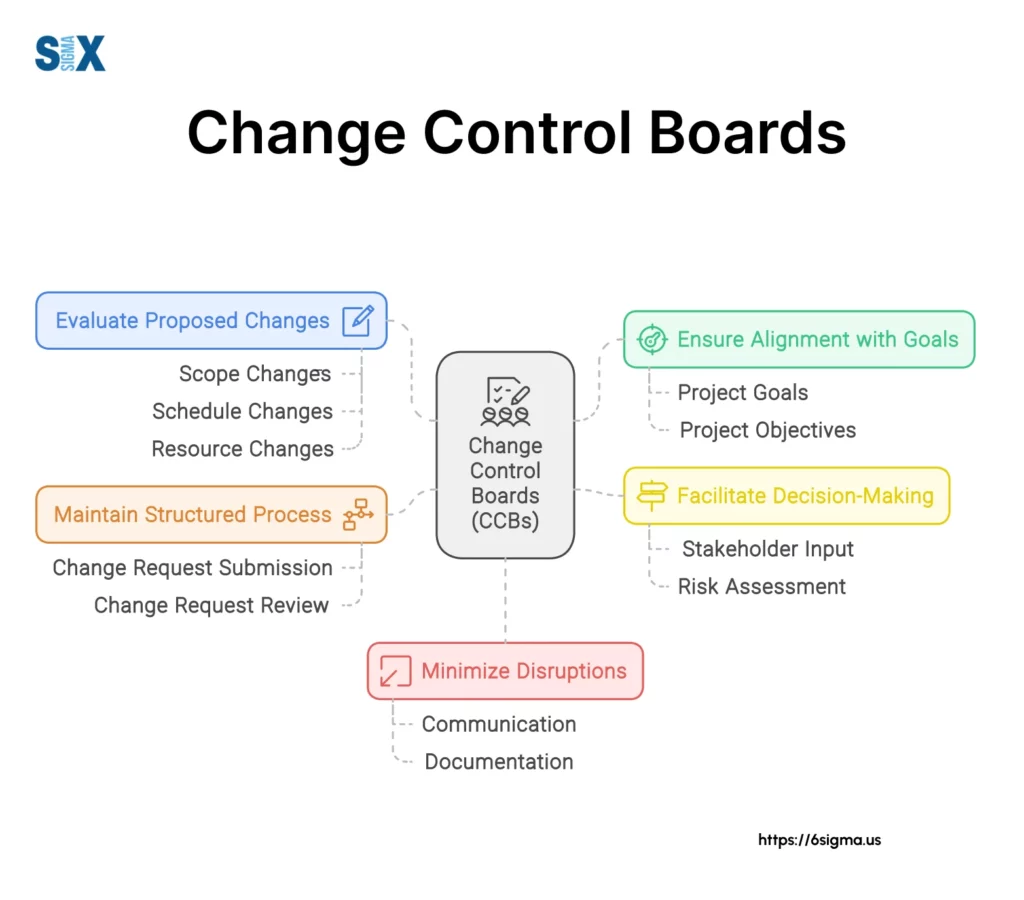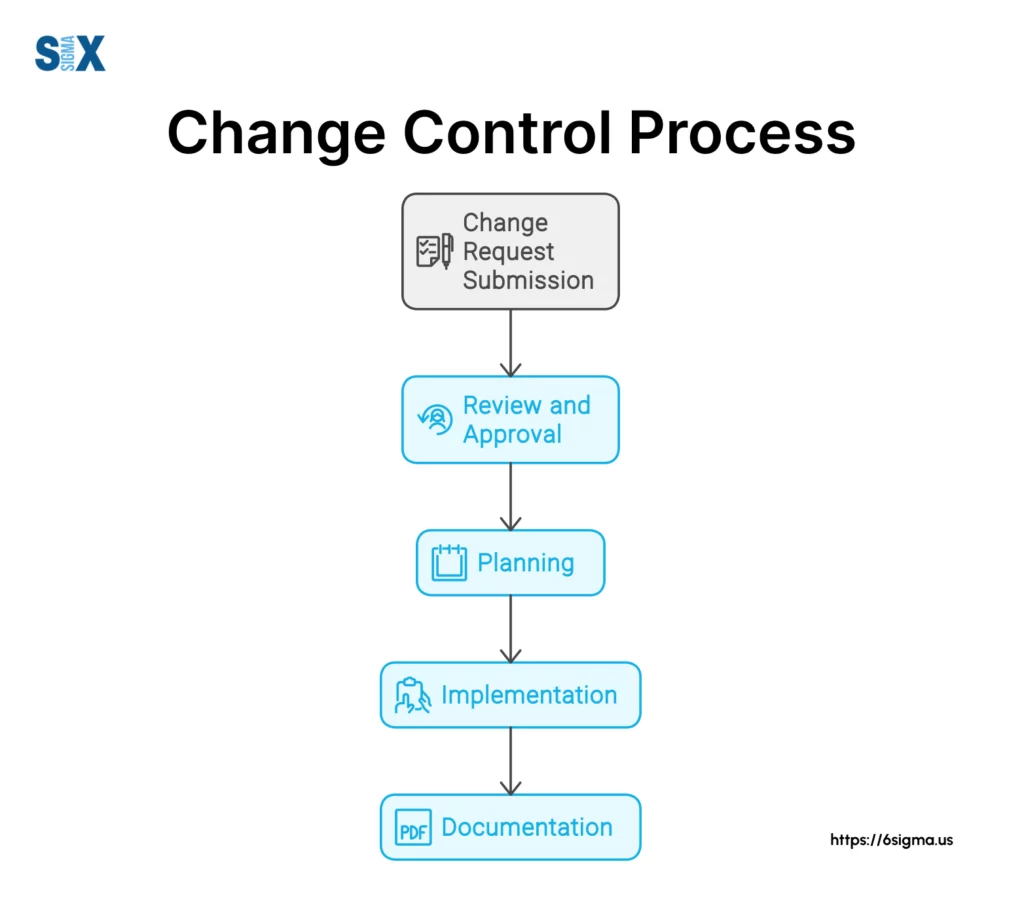The Importance of Change Control Board in Project Management
A Change Control Board is a formal group responsible for reviewing, evaluating, and deciding on proposed changes within a project or organization.
Where change is constant, Change Control Boards serve as the gatekeepers of project integrity, maintaining a delicate balance between flexibility and control.
Key Highlights
- Definition and importance of Change Control Boards
- Structure and stakeholder composition of CCBs
- Step-by-step breakdown of the change control process
- Core responsibilities and functions of CCBs
- Best practices for implementing effective CCBs
- Impact of CCBs on project success metrics
Introduction to Change Control Board (CCB)
A Change Control Board is a formal group of stakeholders responsible for reviewing, evaluating, and deciding on proposed changes within a project or organization.
The primary purpose of a CCB is to ensure that changes are managed systematically, aligning with project objectives and organizational goals.
Importance of Change Control Board in Project Management
They serve as a centralized decision-making body, providing a structured approach to change management.
This is particularly important in complex projects where changes can have far-reaching implications on scope, timeline, and budget.
By implementing a CCB, organizations can maintain control over their projects, mitigate risks, and ensure that changes contribute positively to the project’s overall success.

The Structure and Composition of a Change Control Board
A well-structured Change Control Board is the backbone of effective change management.
Key Stakeholders Involved
The composition of a Change Control Board is crucial to its effectiveness.
Based on my experience leading Six Sigma deployments, I’ve found that a well-structured CCB typically includes:
- Project Manager: Often serves as the chair of the CCB
- Project Sponsor: Provides high-level guidance and support
- Technical Experts: Offer insights on the feasibility and impact of changes
- Business Analysts: Assess the business implications of proposed changes
- Quality Assurance Representatives: Ensure changes meet quality standards
- End-user Representatives: Provide perspective on how changes affect users
Roles and Responsibilities of Change Control Board
Each member of the CCB has specific roles and responsibilities:
- The Project Manager facilitates CCB meetings and ensures proper documentation.
- The Project Sponsor makes final decisions on high-impact changes.
- Technical Experts evaluate the technical feasibility and implications of changes.
- Business Analysts assess the business impact and alignment with organizational goals.
- Quality Assurance Representatives ensure changes meet quality standards.
- End-user Representatives provide insights on user experience and acceptance.
The Change Control Process
The change control process is a systematic approach to managing project modifications.

Submitting Change Requests
The change control process begins with the submission of a change request.
In my workshops on Business Process Charting, I emphasize the importance of a standardized change request form. This form should capture essential information such as:
- Description of the proposed change
- Rationale for the change
- Expected benefits
- Potential impacts on project scope, schedule, and budget
Evaluation and Impact Analysis with Change Control Board
Once a change request is submitted, the CCB conducts a thorough evaluation and impact analysis.
This step is crucial and often involves:
- Assessing technical feasibility
- Analyzing potential risks
- Estimating resource requirements
- Evaluating impact on project timeline and budget
- Considering alternatives
Decision-making and Approval Process
Based on the evaluation and impact analysis, the CCB makes a decision to approve, reject, or defer the change request.
This decision-making process should be transparent and based on predefined criteria.
Implementation and Monitoring with Change Control Board
If a change is approved, the CCB oversees its implementation and monitors its progress.
This involves:
- Updating project plans and documentation
- Allocating resources for implementation
- Tracking the progress of the change
- Assessing the actual impact versus the projected impact
Get detailed explanation of the change control process with Lean Six Sigma Green Belt
Change Control Board (CCB) Responsibilities and Functions
Change Control Boards serve as gatekeepers, managing project scope and mitigating risks.
Managing Project Scope and Preventing Scope Creep
One of the primary responsibilities of a CCB is to manage project scope and prevent scope creep.
Through my work in Six Sigma deployments, I’ve seen how unchecked changes can lead to project bloat and missed deadlines.
The CCB acts as a gatekeeper, ensuring that only necessary and value-adding changes are approved.
Risk Assessment and Mitigation with Change Control Board
Risk management is an integral part of the CCB’s function. By thoroughly evaluating proposed changes, the CCB can identify potential risks and develop mitigation strategies.
This proactive approach to risk management has been crucial in my experience leading international projects.
Ensuring Alignment with Project Objectives
The CCB plays a vital role in ensuring that all approved changes align with the overall project objectives.
This alignment is critical for maintaining project integrity and delivering value to stakeholders.
Documentation and Communication
Proper documentation and communication are essential for effective change management.
The CCB is responsible for maintaining detailed records of all change requests, decisions, and implementations.
Clear communication channels should be established to keep all stakeholders informed about changes and their impacts.
Learn what are the roles and responsibilities of Change Control Boards with Lean Six Sigma Black Belt
Best Practices for Effective Change Control Boards
Implementing clear guidelines and enhancing stakeholder communication are crucial for CCB success.
Establishing Clear Guidelines and Procedures
Based on my experience developing Six Sigma deployment strategies, I recommend establishing clear guidelines and procedures for the CCB.
This includes:
- Defining the change request submission process
- Setting criteria for change evaluation
- Establishing decision-making protocols
- Defining roles and responsibilities of CCB members
Enhancing Stakeholder Alignment and Communication with Change Control Board
Effective communication is key to successful change management. Some best practices include:
- Regular CCB meetings with a structured agenda
- Clear and timely communication of decisions to all stakeholders
- Providing a platform for stakeholders to voice concerns or suggestions
Implementing Robust Tracking and Monitoring Systems
Implementing robust systems for tracking and monitoring changes is crucial.
In my work with companies like Xerox and Seagate, I’ve found that utilizing project management software can greatly enhance the efficiency of change control processes.
The Impact of Change Control Board(s) on Project Success
Change Control Boards play a pivotal role in maintaining project baselines and improving governance.
Maintaining Project Baselines (Scope, Timeline, Budget)
A well-functioning CCB helps maintain project baselines by carefully evaluating and controlling changes. This ensures that the project stays on track in terms of scope, timeline, and budget.
Improving Decision-making and Governance
By providing a structured approach to change management, CCBs improve overall project governance and decision-making.
This leads to more informed decisions and better project outcomes.
Enhancing Quality Assurance with Change Control Boards
Through careful evaluation of proposed changes and their impacts, CCBs play a crucial role in maintaining and enhancing project quality.
This aligns with my experience in Statistical Process Control and Test Method improvement.
Conclusion
In conclusion, Change Control Boards are essential for effective project management.
They provide a structured approach to managing changes, ensuring that projects stay on track and deliver value.
Key points to remember include:
- The importance of a well-structured CCB with clearly defined roles
- The need for a systematic change control process
- The critical functions of scope management, risk assessment, and stakeholder alignment
- The impact of effective change control on project success
Looking ahead, I believe that CCBs will continue to evolve with advancements in technology and project management methodologies.
We’re likely to see increased integration of AI and machine learning in change impact analysis, as well as more agile approaches to change management in fast-paced environments.
As projects become more complex and interconnected, the role of CCBs in ensuring project success will only grow in importance.
SixSigma.us offers both Live Virtual classes as well as Online Self-Paced training. Most option includes access to the same great Master Black Belt instructors that teach our World Class in-person sessions. Sign-up today!
Virtual Classroom Training Programs Self-Paced Online Training Programs






